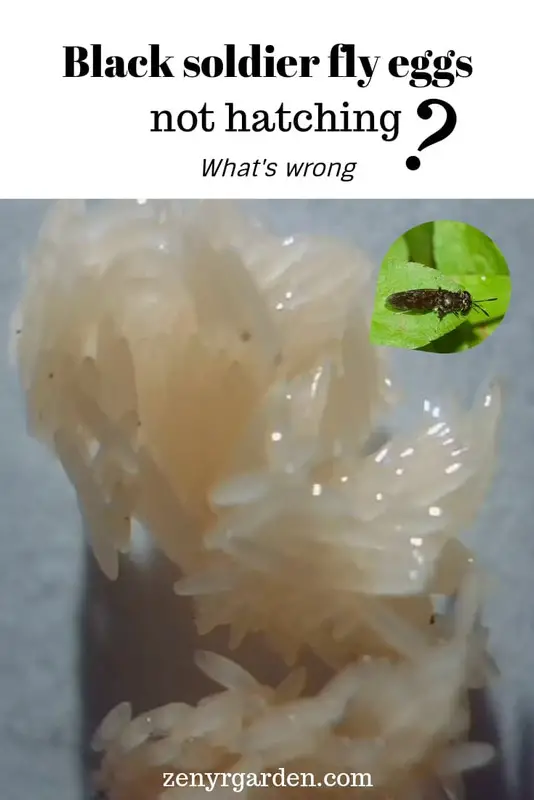To tell whether the black soldier fly eggs have hatched or not, you can look at the color of the eggs and their texture. The fresh eggs are usually light yellow. They cluster up together because there's still some moisture in them. The eggs that have already hatched have a slightly darker color.
Here is an example of fresh unhatched BSF eggs and hatched ones. You can see the difference in color and texture here:
/black-soldier-fly-eggs-hatched-unhatched.jpg)
What we're seeing in the pic above are the shells of the eggs. The larvae have already crawled out of them. These shells are more fluffy, lighter & a bit more dry.
After checking to make sure if the eggs have hatched or not, we can begin to look at some reasons why some eggs are still not cracking out. Let's see the reasons right below:
Reason #1: Shipping Factors
If you order eggs somewhere far away, during shipping if the box is kept near a hot place, then it can damage the eggs & their viability. A good temperature for eggs this time is around 29C (84F).
Check with your egg source if they cover compensation in this case. Many would happily replace you with new eggs. Also, it's good not to buy from a place too far from you. Because BSF eggs hatch very fast. It takes around 4-5 days only for hatching. If they don't pack the box well, it may be a risk for your money.
Another reason why the BSF eggs may not be hatching is because of:
Reason #2: Temperature Shock
Make sure there is little temperature or humidity shock as you unbox the eggs. Some sellers advise us to just open the egg box lid & place the box directly on the starter feed. That's all we have to do & nothing else. No messing with them too much or too frequent changes.
It's a good idea to keep your eggs in a shaded area to prevent moisture loss. Place a mesh screen over your feed bed (where you place the egg box on) to prevent houseflies from laying their eggs there.
The contact with too much moisture may reduce egg hatching rate. So keep them in a dry, cool place. When you prepare the feed bed, keep the moisture content around 70%. Don't let it go too dry or hardened. Chicken feed, pig feed or rice bran mixed with water is good. Spray it lightly when you see the surface dries up.
Sometimes, we may just need a bit more:
Patience
Finally, have you given it enough time for the eggs to hatch? Many beginners are very excited & eager to see the eggs hatch. In the first few days, you may not see much happening. But be patient.
We may not even see the hatchlings during the first few days because they are very tiny. After they hatch, from the 5th day on if you give them good food, they'll grow very big & fat.
Check also for ants around. These little things are yummy treats for the ants. Before preparing a feed bed, some growers spray anti-ant spray around the box just to play it safe. Little larvae are quite allergic to solution like this so spray it around but not directly on the box.
Summary
In conclusion, to understand why the BSF eggs may not be hatching take a look at several aspects:
- Good, reliable egg suppliers
- Suitable temperature & conditions
- Minimizing shocks for the eggs new house
- Excess moisture that could damage the eggs
- Too much touching, messing, scraping of the eggs
- Good feed but not too dry or too wet
- Ants or other insects that may steal your eggs
- Some more time to see the magic happens
BSF eggs are not overly difficult to hatch or incubate. If you're still stuck, try getting the larvae. They have thousands of worms in a box for about $20. Popworms or Northwest Redworms are two good sellers. It can help you get a good start with BSF.
Also, try attracting wild BSF in your local area using food waste or some fruits/veggies. From some growers' experience, local BSF are better adapted to each local environment. Their health, their growth or resistance have been 'climatized' to suit the hot & cold in the area. This is another good idea to get started with.
>> Blog post: How to attract BSF
Be on the cautious side if you get your worms from some pet stores. We heard in some places they use a chemical spray so the worms won't pupate (or turn into flies). So you may not get any returns for those.
If you would like to see how to incubate BSF eggs, check out this post right here:
>> Blog post: How to incubate BSF eggs
With that said, good luck & have fun with your new BSF projects!
Share or pin this post!


